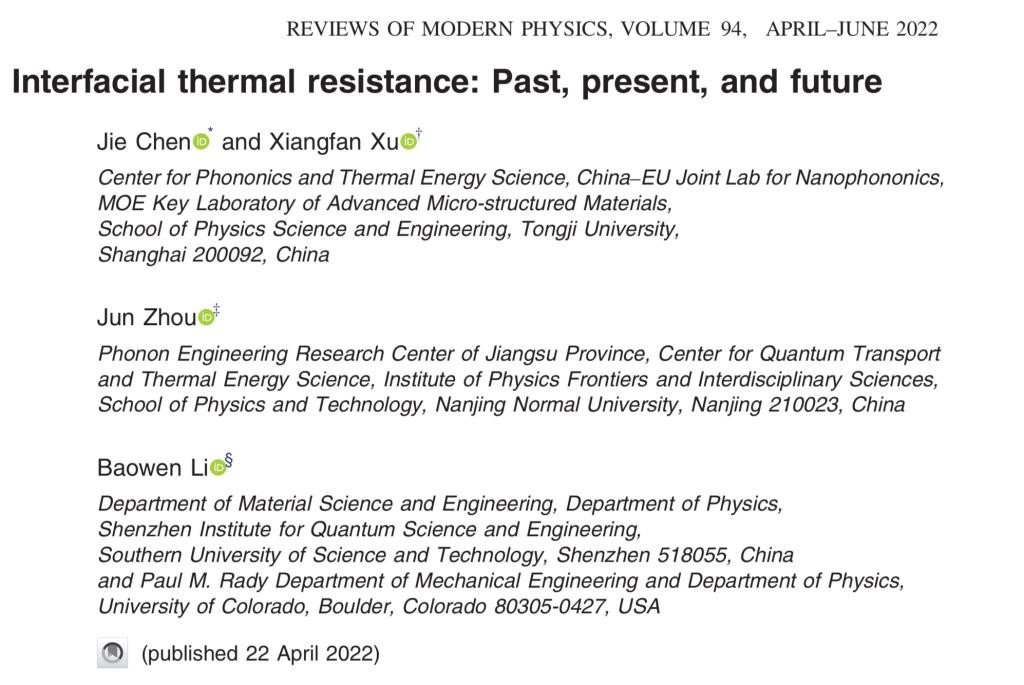On April 22, a long review article entitled "Interface thermal resistance: past, present and future" (50 pages) by a Tongji research team was published in Reviews of Modern Physics (RMP) to commemorate the 200th anniversary of the discovery of interface thermal resistance. The authors are Professor CHEN Jie and Professor XU Xiangfan from the School of Physical Science and Engineering / Phonon and Thermal Energy Science Center of Tongji University, Professor ZHOU Jun from the Quantum Transport and Thermal Energy Science Center of Nanjing Normal University, and Professor LI Baowen from the Department of Materials Science and Engineering and the Department of Physics of Southern University of Science and Technology. This article presents a comprehensive introduction of the rapid development of interfacial thermal resistance in recent 30 years from the perspective of theoretical model and experimental technology.

The long article published in Reviews of Modern Physics
Heat dissipation determines the working performance and stability of a device which is made of micro nano components, whether they are electronic or optoelectronic ones. High density components produce much heat during high-speed operation. If the heat cannot be dredged out in time, the performance of components will be reduced or even burned out due to local high temperature (commonly known as hot spot). How to conduct excessive heat and make components operate in relatively low temperature environment is a common problem faced by modern semiconductor industry. At present, most electronic devices are made of semiconductors or metals, and the main media of their heat energy is phonons or electrons. Therefore, issues on heat dissipation in micro nano components are of great significance in the research on phonon and electron heat transfer. In integrated circuits, the diffusion of heat from components to the package shell needs to pass through countless semiconductor-semiconductor and semiconductor-metal interfaces. Therefore, the problem of heat dissipation involves the very basic scientific problem in physics and engineering: how does heat (phonons, electrons) pass through various interfaces? How do electron- phonon coupling and phonon-phonon coupling affect the interfacial thermal resistance?
Due to the difference in material composition and structure on both sides of the interface, hot carriers will be scattered when passing through the interface, resulting in temperature jump at both ends of the interface at micro and nano scales, which can define the interface thermal resistance. Physicist J. B. J. Fourier first discovered the temperature jump at the interface in 1822. He put forward the concept of "external conductivity" based on his findings that the heat lost from the solid surface to the surrounding gas has a certain relationship with the temperature difference. Physicist Poisson proposed in 1835 that the total heat passing through the interface is directly proportional to the temperature difference on both sides, and defined the interface thermal resistance. Polish scientist M. Smoluchowski and former Soviet scientist P. L. Kapitza measured the interfacial thermal resistance of solid gas and solid liquid in 1898 and 1941, respectively.
This is the third long review on interfacial thermal resistance published in the history of RMP. The previous two articles were published in 1969 and 1989 respectively, and both focusing on the heat transfer of macro materials and macro interfaces. The commonly used interface thermal resistance theory, such as AMM and DMM, assumed that phonons passed through the interface in the form of ballistic transmission or diffusion transmission. Therefore, there was an order of magnitude deviation between the predicted results of the two models and the experimental results. At the same time, due to the lack of measurement means and the difficulty of experiment, the experimental research on interfacial thermal conductivity in the early stage was rather limited. With the development of nanotechnology and the improvement of nano preparation technology, and thanks to the application of modern mainframe computers, the research on interfacial thermal resistance has made great progress in recent 30 years. In view of this, this article provides a systematic and comprehensive introduction of the rapid development of this field in recent 30 years from the perspective of theoretical model and experimental technology. It analyses the research progress and existing problems of thermal resistance of solid-solid interface, solid-liquid interface and solid-gas interface, explores the definition of interface and temperature, geometric effect of interface thermal resistance, regulation of interface thermal resistance, and discusses the applicability of AMM, DMM and two temperature models.
The research work was supported by research funds for projects of the NSFC, projects of the Ministry of Science and Technology, for a project of R&D Plans in Key Fields of Guangdong Province, and for a project of Shanghai Science and Technology Commission.
RMP is a quarterly peer-reviewed journal published by the American Physical Society. Established in 1929, the journal publishes review articles, usually by established researchers, on all aspects of physics and related fields. The reviews are usually accessible to non-specialists and serve as introductory material to graduate students, which survey recent work, discuss key problems to be solved and provide perspectives toward the end. RMP is arguably one of the most, if not the most, prestigious, authoritative and highly impacting journals in the field of physics. Up to now, only a dozen papers have been published by higher education and research institutions in China’s Mainland. The publication of this paper shows the profound accumulation and leading position of Tongji University in the scientific and technological field of micro nano scale interface heat transfer in the world.
Link to paper: https://journals.aps.org/rmp/abstract/10.1103/RevModPhys.94.025002
Source: https://news.tongji.edu.cn/info/1003/80746.htm